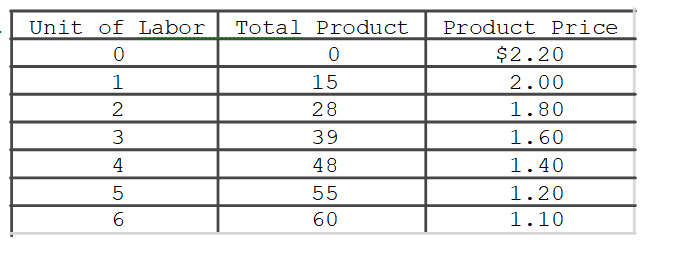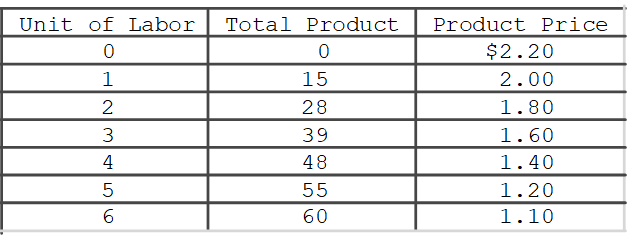A) the increase in a firm's total cost caused by hiring one additional unit of an input.
B) a firm's cost of hiring one group of inputs, such as capital or labor.
C) the firm's demand curve for a productive resource.
D) determined by the marginal physical product schedule for an input.
Correct Answer

verified
Correct Answer
verified
Multiple Choice
 Refer to the table, which gives data for a firm that is hiring labor in a purely competitive market.If the wage rate is $20, how many workers will the firm choose to employ?
Refer to the table, which gives data for a firm that is hiring labor in a purely competitive market.If the wage rate is $20, how many workers will the firm choose to employ?
A) 5
B) 4
C) 3
D) 2
Correct Answer

verified
Correct Answer
verified
Multiple Choice
A firm combines two resources, A and B, to produce an output, Q.Their respective marginal revenue products are $30 and $21.A costs $15 a unit and B $7 a unit.To reduce the cost of Q,
A) more B and less A should be used.
B) more A and less B should be used.
C) more of both resources should be used.
D) less of both resources should be used.
Correct Answer

verified
Correct Answer
verified
Multiple Choice
If a firm is hiring variable resources D and F in perfectly competitive input markets, it will minimize the cost of producing any level of output by employing D and F in such amounts that
A) the price of each input equals its MP.
B) MPD = MPF.
C) MPD / PD = MPF / PF.
D) MPD / PF = MPF / PD.
Correct Answer

verified
Correct Answer
verified
Multiple Choice
Suppose the price of the product that labor is producing increases and simultaneously the price of capital, which is substitutable for labor, decreases.Assuming that the substitution effect is greater than the output effect, the demand for labor
A) will increase.
B) will decrease.
C) may either increase or decrease.
D) will not change.
Correct Answer

verified
Correct Answer
verified
Multiple Choice
Other things equal, we would expect the labor demand curve of a monopolistic seller to
A) decline more rapidly than that of a purely competitive seller.
B) decline less rapidly than that of a purely competitive seller.
C) decline at the same rate as that of a purely competitive seller.
D) be more elastic than that of a purely competitive seller.
Correct Answer

verified
Correct Answer
verified
Multiple Choice
Assume labor is the only variable input and that an additional input of labor increases total output from 72 to 80 units.If the product sells for $6 per unit in a purely competitive market, the MRP of this additional worker is
A) $6.
B) $8.
C) $48.
D) $80.
Correct Answer

verified
Correct Answer
verified
Multiple Choice
Which would result in a decrease in the elasticity of demand for a particular resource?
A) a decrease in the rate at which the marginal product of that resource declines
B) an increase in the elasticity of demand for the product that the resource helps to produce
C) a decrease in the percentage of the firm's total costs accounted for by the resource
D) an increase in the substitutability of other resources for the particular resource
Correct Answer

verified
Correct Answer
verified
Multiple Choice
All firms have to incur costs because of
A) the resources they use.
B) buyers they sell to.
C) the profits they earn.
D) revenues they receive.
Correct Answer

verified
Correct Answer
verified
Multiple Choice
A farmer who has fixed amounts of land and capital finds that total product is 24 for the first worker hired, 32 when two workers are hired, 37 when three are hired, and 40 when four are hired.The farmer's product sells for $3 per unit, and the wage rate is $13 per worker.What is the farmer's profit-maximizing output?
A) 20
B) 32
C) 37
D) 40
Correct Answer

verified
Correct Answer
verified
Multiple Choice
A farmer who has fixed amounts of land and capital finds that total product is 24 for the first worker hired, 32 when two workers are hired, 37 when three are hired, and 40 when four are hired.The farmer's product sells for $3 per unit, and the wage rate is $13 per worker.How many workers should the farmer hire?
A) 1
B) 2
C) 3
D) 4
Correct Answer

verified
Correct Answer
verified
Multiple Choice
Suppose capital is readily substitutable for labor and that the price of capital falls.We can conclude that the
A) substitution effect will tend to reduce the demand for labor.
B) output effect will tend to reduce the demand for labor.
C) demand for labor will necessarily decline.
D) demand for labor will necessarily increase.
Correct Answer

verified
Correct Answer
verified
True/False
Changes in the price of a product would not shift the demand for the resources needed to produce the product.
Correct Answer

verified
Correct Answer
verified
Multiple Choice
Marginal revenue product measures the
A) amount by which the addition of one more worker increases a firm's total revenue.
B) decline in product price that a firm must accept to sell the extra output of one more worker.
C) increase in total resource cost resulting from the hire of one extra unit of a resource.
D) increase in total revenue resulting from the production of one more unit of a product.
Correct Answer

verified
Correct Answer
verified
Multiple Choice
A firm is employing inputs such that the marginal product of labor is 25 and the marginal product of capital is 40.The price of labor is $5, and the price of capital is $8.If the firm wants to minimize costs, then it should
A) use more labor and less capital.
B) use less labor and less capital.
C) use less labor and more capital.
D) make no change in resource use.
Correct Answer

verified
Correct Answer
verified
Multiple Choice
A farmer who has fixed amounts of land and capital finds that total product is 24 for the first worker hired, 32 when two workers are hired, 37 when three are hired, and 40 when four are hired.The farmer's product sells for $3 per unit, and the wage rate is $13 per worker.The marginal revenue product of the second worker is
A) $24.
B) $8.
C) $15.
D) $9.
Correct Answer

verified
Correct Answer
verified
True/False
A firm's demand schedule for a resource is the firm's marginal product schedule for the resource.
Correct Answer

verified
Correct Answer
verified
Multiple Choice
An example of derived demand in the auto industry is the demand for
A) new automobiles.
B) used automobiles.
C) auto workers.
D) drivers' insurance.
Correct Answer

verified
Correct Answer
verified
Multiple Choice
 Refer to the table, which gives data for a firm that is hiring labor in a purely competitive market.If the wage rate is $11, how many workers will the firm choose to employ?
Refer to the table, which gives data for a firm that is hiring labor in a purely competitive market.If the wage rate is $11, how many workers will the firm choose to employ?
A) 5.
B) 4.
C) 3.
D) 2.Blooms: Understand
Correct Answer

verified
Correct Answer
verified
Multiple Choice
Which of the following increases in labor demand is due to a change in the price of a related resource?
A) Software sales rise, thus increasing the demand for software developers.
B) Snowboarding increases in popularity, thus increasing the demand for the workers who make snowboards.
C) A decrease in the price of wood decreases the cost of furniture, thus increasing the demand for furniture workers.
D) A technological change increases output per worker in the computer industry, thus increasing the demand for computer workers.
Correct Answer

verified
Correct Answer
verified
Showing 61 - 80 of 231
Related Exams